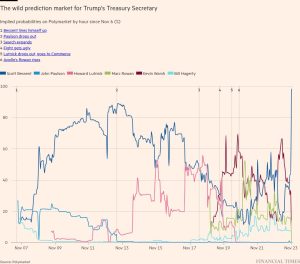ECB lowers rates to 3.25%
Unlock the Editor’s Digest for free
Roula Khalaf, Editor of the FT, selects her favourite stories in this weekly newsletter.
The European Central Bank has cut interest rates by a quarter-point to 3.25 per cent, amid signs that growth and inflation in the Eurozone are weakening.
Thursday’s move took Eurozone rates to their lowest point since May 2023 and followed a cut of the same size at the ECB’s last meeting, held in early September.
While the cut was widely anticipated, the ECB said it was based on an “updated assessment of the inflation outlook”.
That suggested price pressures could now be weaker than the central bank forecast last month, when it predicted inflation would rise towards the end of the year but dip back under its 2 per cent target in 2025.
ECB president Christine Lagarde said after the meeting that the disinflationary process was “well on track” and that all of the data since the September vote “were heading in the same direction — lower”.
Lagarde said the decision to cut by 25 basis points was unanimous and that the recent data had “certainly improved our confidence” that the central bank was on track to hit its 2 per cent goal. “Have we broken the neck of inflation? Not yet. Are we in the process of breaking that neck? Yes.”
The euro was slightly weaker in early trading after the announcement, at $1.084.
Cutting rates just five weeks after the previous move and with little additional economic data indicated that “the ECB must have become much more concerned about the Eurozone’s growth outlook and the risk of inflation undershooting the target”, Carsten Brzeski, global head of macro at ING, said in a note to clients.
Eurozone inflation fell to 1.7 per cent in the year to September, sinking below 2 per cent for the first time in more than three years.
“The incoming information on inflation shows that the disinflationary process is well on track,” the ECB said. “The inflation outlook is also affected by recent downside surprises in indicators of economic activity.”
German officials have warned Europe’s biggest economy is set to shrink for the second consecutive year.
However, Lagarde said rate-setters did not see a recession in the Eurozone as the most likely scenario. “We are looking at a soft landing,” she said.
Traders in swaps markets price in another four or five quarter-point rate cuts by the middle of next year, including the near-certainty of a reduction in December. Policymakers maintain that they will not pre-commit to a rate cut at their final meeting of 2024.
The euro has fallen more than 2 per cent against the dollar over the past month as expectations grew of faster rate cuts.
The ECB itself gave little guidance over the future path of its monetary policy on Thursday. It reiterated it was taking “a data-dependent and meeting-by-meeting approach” and was “not pre-committing to a particular rate path”.
Deutsche Bank’s chief European economist Mark Wall said Thursday’s decision could represent a “pivot” towards a faster return to lower rates.
The US Federal Reserve reduced its benchmark interest rate in September for the first time in more than four years, lowering borrowing costs by a half-point and signalling more reductions on the way.
The Bank of England is also expected to lower rates again in November, after cuts earlier this year.
The ECB started to cut rates in June and has now lowered borrowing costs three times. Thursday’s decision was made in Ljubljana, at the Slovenian central bank.
#ECB #lowers #rates





